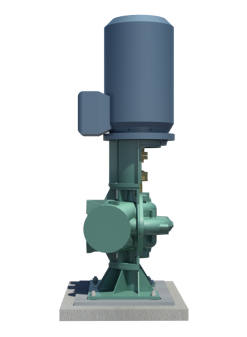District cooling provides chilled water in an efficient manner with minimal effect on the environment. A centralized cooling plant distributes the cooling water via a network to industrial, commercial, and multiple residential buildings. We must reiterate the huge dependence of the success of any DC network on the soundness of the pumping system. ARANER is a renowned provider of pumping technology for the centralized cooling plant, piping network, and water intake. Pump efficiency is of such critical importance in DC performance that we focus on it throughout the design process. In this article, we look at the details of this parameter and explain its applicability in the industry.
Energy Consumption Variations
Examples of pumps in a district cooling setup are Condenser Water Pumps, primary Chilled Water Pumps, and building side pumping. Centrifugal pumps are popular in DC, but other categories of pumps feature as well.

Fig 1: A Centrifugal Pump
It's common knowledge that the pumping system in district cooling consumes energy. The higher the number and the bigger in size of the pumps, the more energy use and the less energy efficient the DC system becomes. Some pump types consume more energy than others. This is why the pumps mentioned must be managed expertly for maximum pump efficiency. Only reputable providers such as ARANER are capable of adhering to the DC pumping best practices, down to the last detail.
Designing the Pumping System
Some engineers use their own style of plant designs, with a successful concept being difficult to change. Subsequent projects will most likely follow the same signature in a ‘copy-and-paste’ manner. However, this approach can result in a system whose energy consumption per ton-hour is unacceptably high. For pumps, excessive pressure may be developed, prompting the operators to resort to partial closure of valves. Substantial pressure loss can only mean more demand on the pumps, and subsequently, increased energy consumption. Only a correctly-sized pumping system can guarantee the required pump efficiency and cost savings. An engineering evaluation is the best step to start the design of a district cooling pumping system. An ideal first step for this evaluation is the development of load profiles for every facility within the district loop. Another crucial step is the baseline flow analysis, which involves modeling the piping loop. Next come flow analysis models, followed by engineering drawings in readiness for implementation. Developing all models is key, as it ensures the district cooling plant serves users according to real operating conditions.
Opportunities for Higher Pump Efficiency
There are countless ways of enhancing pump efficiency in a DC system. Let's look at some of them under the following two categories:
1. Pump Assessment and Survey
Any step you make towards enhancing pump efficiency must start from a point of analyzing the current performance. For proper management of the DC pumping system, important information includes maintenance, function, and control requirements. Some of the data you can get through this process is planned & preventative maintenance, service provided, and energy efficiency opportunities.
2. Reduced Service Demand
You can reduce the number of pumps needed by reducing the necessity of a service. The bottom line will improve in a number of ways. For example, there will be a reduction in maintenance costs, capital costs, and operational energy costs. One way to achieve this in a district cooling setup is to reduce wastewater generation by modifying the process. This way, less pumping will be required for water treatment and water transport in the process. Further service demand can be eliminated by minimizing resistance to flow. The DC designer must use adequate pipe diameters, minimize pipe length, remove restrictors, and minimize bends. System optimization is the best way to reduce pumping demand within a DC system. This offers proprietors a perfect opportunity to gain higher energy savings, compared to an approach whereby efficiency of individual pumps is enhanced. Determining the efficiency of the overall pump system is easy: compare the minimum energy theoretically needed with the input energy. With pump documentation, meters and design information, this process can be extremely easy. As you undertake this process, remember that aspects related to the pumping mechanism can also affect pump efficiency. For instance, the drive and motor belong to the same system as the pump.
The pumping system is the core of a district cooling network because it has a remarkable effect on the efficiency of other components in the network. That's why it is highly recommendable to dwell on pump efficiency during the design of a DC system. ARANER has the expertise and technology to ensure the correct sizing and selection of pumps for any district cooling project.










